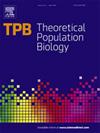Identity-by-descent segments in large samples
IF 1.3
4区 生物学
Q4 ECOLOGY
引用次数: 0
Abstract
If two haplotypes share the same alleles for an extended gene tract, these haplotypes are likely to be derived identical-by-descent from a recent common ancestor. Identity-by-descent segment lengths are correlated via unobserved ancestral tree and recombination processes, which commonly presents challenges to the derivation of theoretical results in population genetics. We show that the proportion of detectable identity-by-descent segments around a locus is normally distributed when the sample size and the scaled population size are large. We generalize this central limit theorem to cover flexible demographic scenarios, multi-way identity-by-descent segments, and multivariate identity-by-descent rates. The regularity conditions on sample size and scaled population size are unlikely to hold in genetic data from real populations, but provide intuition for when the Gaussian distribution may be a reasonable approximate model for the IBD rate. We use efficient simulations to study the distributional behavior of the detectable identity-by-descent rate. One consequence of non-normality in finite samples is that a genome-wide scan looking for excess identity-by-descent rates may be subject to anti-conservative control of family-wise error rates.
大样本中的血统识别片段。
如果两个单倍型在一个扩展的基因束中具有相同的等位基因,那么这些单倍型很可能是由最近的共同祖先遗传而来的。血统身份片段长度通过未观察到的祖先树和重组过程相关联,这通常对群体遗传学理论结果的推导提出了挑战。我们表明,当样本大小和尺度总体大小较大时,基因座周围可检测的血统身份片段的比例呈正态分布。我们将这个中心极限定理推广到灵活的人口统计场景、多向血统分段和多变量血统率。样本大小和比例群体大小的规则条件不太可能在真实群体的遗传数据中成立,但为高斯分布何时可能是IBD率的合理近似模型提供了直觉。我们使用有效的模拟来研究可检测的下降身份率的分布行为。在有限样本中,非正态性的一个后果是,在全基因组扫描中寻找过多的血统识别率,可能会受到家庭误差率的反保守控制。
本文章由计算机程序翻译,如有差异,请以英文原文为准。
求助全文
约1分钟内获得全文
求助全文
来源期刊

Theoretical Population Biology
生物-进化生物学
CiteScore
2.50
自引率
14.30%
发文量
43
审稿时长
6-12 weeks
期刊介绍:
An interdisciplinary journal, Theoretical Population Biology presents articles on theoretical aspects of the biology of populations, particularly in the areas of demography, ecology, epidemiology, evolution, and genetics. Emphasis is on the development of mathematical theory and models that enhance the understanding of biological phenomena.
Articles highlight the motivation and significance of the work for advancing progress in biology, relying on a substantial mathematical effort to obtain biological insight. The journal also presents empirical results and computational and statistical methods directly impinging on theoretical problems in population biology.
 求助内容:
求助内容: 应助结果提醒方式:
应助结果提醒方式:


